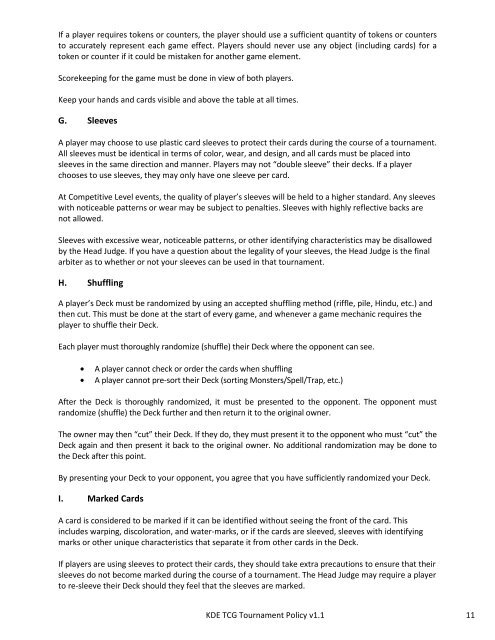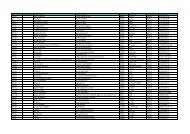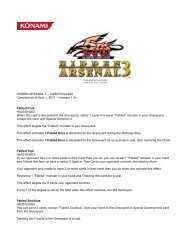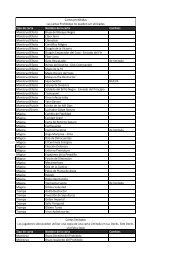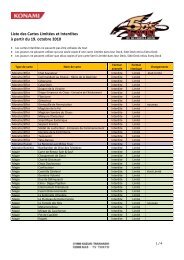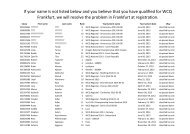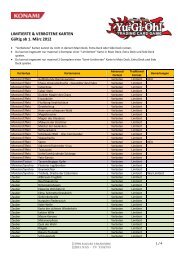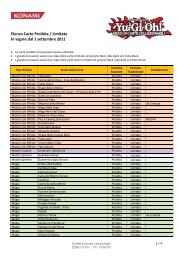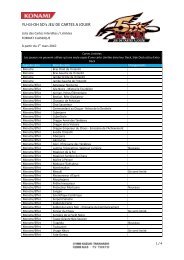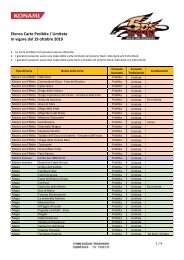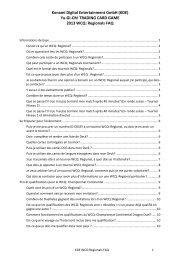KDE TCG Tournament Policy v1.1 - Yu-Gi-Oh!
KDE TCG Tournament Policy v1.1 - Yu-Gi-Oh!
KDE TCG Tournament Policy v1.1 - Yu-Gi-Oh!
You also want an ePaper? Increase the reach of your titles
YUMPU automatically turns print PDFs into web optimized ePapers that Google loves.
If a player requires tokens or counters, the player should use a sufficient quantity of tokens or countersto accurately represent each game effect. Players should never use any object (including cards) for atoken or counter if it could be mistaken for another game element.Scorekeeping for the game must be done in view of both players.Keep your hands and cards visible and above the table at all times.G. SleevesA player may choose to use plastic card sleeves to protect their cards during the course of a tournament.All sleeves must be identical in terms of color, wear, and design, and all cards must be placed intosleeves in the same direction and manner. Players may not “double sleeve” their decks. If a playerchooses to use sleeves, they may only have one sleeve per card.At Competitive Level events, the quality of player’s sleeves will be held to a higher standard. Any sleeveswith noticeable patterns or wear may be subject to penalties. Sleeves with highly reflective backs arenot allowed.Sleeves with excessive wear, noticeable patterns, or other identifying characteristics may be disallowedby the Head Judge. If you have a question about the legality of your sleeves, the Head Judge is the finalarbiter as to whether or not your sleeves can be used in that tournament.H. ShufflingA player’s Deck must be randomized by using an accepted shuffling method (riffle, pile, Hindu, etc.) andthen cut. This must be done at the start of every game, and whenever a game mechanic requires theplayer to shuffle their Deck.Each player must thoroughly randomize (shuffle) their Deck where the opponent can see.• A player cannot check or order the cards when shuffling• A player cannot pre-sort their Deck (sorting Monsters/Spell/Trap, etc.)After the Deck is thoroughly randomized, it must be presented to the opponent. The opponent mustrandomize (shuffle) the Deck further and then return it to the original owner.The owner may then “cut” their Deck. If they do, they must present it to the opponent who must “cut” theDeck again and then present it back to the original owner. No additional randomization may be done tothe Deck after this point.By presenting your Deck to your opponent, you agree that you have sufficiently randomized your Deck.I. Marked CardsA card is considered to be marked if it can be identified without seeing the front of the card. Thisincludes warping, discoloration, and water-marks, or if the cards are sleeved, sleeves with identifyingmarks or other unique characteristics that separate it from other cards in the Deck.If players are using sleeves to protect their cards, they should take extra precautions to ensure that theirsleeves do not become marked during the course of a tournament. The Head Judge may require a playerto re-sleeve their Deck should they feel that the sleeves are marked.<strong>KDE</strong> <strong>TCG</strong> <strong>Tournament</strong> <strong>Policy</strong> <strong>v1.1</strong> 11


